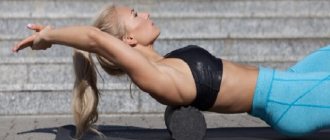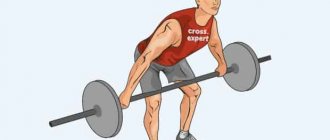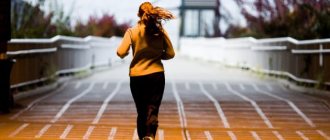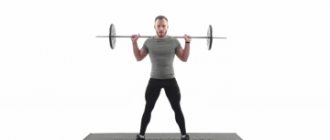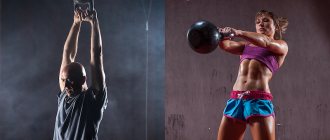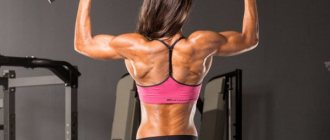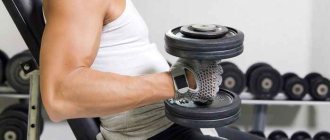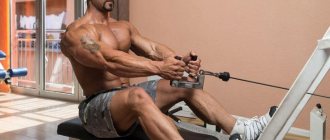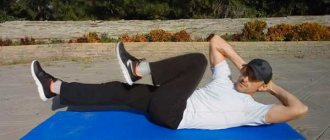In pursuit of a beautiful and attractive body, many women during training focus on the buttocks and abs, forgetting about the back and shoulders. But they play an important role in creating a beautiful and fit body.
In addition, strengthening the muscular frame on the back will prevent the occurrence of various problems with it, as well as support the spine and protect it from curvature.
Exercise 2. Using dumbbells
To form a beautiful shoulder profile, experienced trainers recommend performing flyovers. To perform the exercise, you need to place your feet shoulder-width apart.
Place your arms down your body – they are straight and relaxed. In both hands, take a dumbbell or container with liquid/sand. Raise your arms until they form a parallel line with the floor.
Important! When performing back exercises, you should do them carefully to prevent injury.
A universal set of exercises for men for 4 workouts
Author: Timko Ilya
- the ruler of the entire site and fitness trainer.
Date: 2015-12-26 All articles by the author >
Purpose of the plan: a universal plan. That is, it is equally suitable for weight loss, relief and weight gain.
Plan objectives:
1. Increase muscle mass 2. Burn fat 3. Develop strength endurance
Methods of execution: alternating supersets
Duration: about 2 months.
Difficulty: (very hard)
Plan Features:
- Upper body focus
- Trisets for one muscle group
- Crazy pumping
- Versatility
This training plan is universal in that it is suitable for any purpose: for weight loss, for relief, and for mass. This plan is based on the alternating superset method. It is he who gives this plan such versatility.
Execution principle.
Start with the first superset (3 exercises under one number). You need to do one set of each of the first 3 exercises without rest. Right after each other. Then rest for about 3-4 minutes. After resting, you move on to the second three exercises. Then - to the third. After you do one approach from each three exercises in this way (that is, you reach the end of the workout), you start from the beginning. And so on until you make 3 such circles. Thus, each workout consists of 3 circuits, each circuit of 3 supersets, and each superset of 3 exercises.
Now about how to direct the effect of the plan towards weight loss, or towards mass? Firstly, diet. Under Plan, select a diet that suits your goals. Secondly, the number of repetitions. Opposite each exercise there are 2 options for the number of repetitions. The first option is for mass, and the second is for relief or weight loss (but no more than 20 repetitions).
Each superset must be done to failure. That is, the maximum number of repetitions. This is a must. The exception is abdominal exercises. Then the plan will be most effective. But you need to remember that the weights must be such that this maximum number of repetitions fits within the framework indicated opposite the exercises.
It is allowed to reduce weights from lap to lap. The main thing is to stick to the given rep range. You can also change exercises in different circuits using the "analog" button to vary your workouts. Just don't overdo it. Remember: one superset - one muscle group. By the way, beginner athletes should not do this plan. It's quite complex.
You will train your back, shoulders and abs 2 times a week. Other muscles – 1 time. However, biceps, for example, also work in back exercises. And triceps - in shoulder exercises. Therefore, the load on the upper body will be very large.
If anyone is training for relief or weight loss, you can add cardio (treadmill, elliptical, etc.) for 15 to 20 minutes at the end of each workout. If, of course, there is strength left.
An intelligent reader may have a question: how can the plan “guess” which of the goals I am pursuing? The plan won't guess. The diet will guess. Since each exercise in each superset targets one muscle group, this load promotes muscle growth. And overall training intensity promotes weight loss. And so that it doesn’t work out like a swan, a crayfish and a pike, the diet will outweigh the balance of the effect. And the number of repetitions will help her with this. So it turns out that with the help of such simple manipulations you can train according to this program for any purpose. Don't believe me? Check it out for yourself)) Good luck!
Exercise 4. Plank
The plank is an excellent exercise that should be performed in any complex. With its help, you can not only strengthen the muscles of your arms, but also the muscles of your entire body. After all, while doing the plank, almost all muscle groups are tensed, which has a positive effect on the appearance of the body.
It is recommended to start doing the plank for 20 seconds, then gradually increasing the time to 1 minute or more. It must be done every day.
Important! The plank is an ideal exercise that can be performed every day, gradually increasing the time.
Method 1. Back exercises with your own body weight
The first complex is suitable for training for those who want to pump up their back muscles without exercise equipment or additional weights.
Inverted snow angel
For this exercise, you need to spread your arms wide, describing a circle, as if you were back in childhood, frolicking in the snow. At the same time, the arms move through the full amplitude of the “angel wings” - from behind the head to the hips - for a total development of the trapezius, latissimus, rhomboid and extensor muscles. When you can keep your torso and arms above the floor, move your shoulders back and maintain this position for maximum muscle tension.
- Lie face down on the floor or mat. Extend your arms along your body, palms down.
- Slowly extend your arms out to the sides until you touch the back of your head, connecting your thumbs.
- Slowly return your hands to the starting position. Make sure your arms are straight and your elbows are firmly locked throughout the exercise.
- Do three sets of five reps. Rest 30-60 seconds between sets.
- If you are a beginner and find it difficult to move through the full amplitude, you can raise your arms to shoulder level. Gradually your muscles will become stronger and you will be able to move them behind the back of your head.
Standing body bends
This simple exercise, also called the "good morning" exercise, involves bending your body forward while flexing your hips. By performing this simple movement that does not require any additional equipment, you will work the extensors of the spine (as well as the buttocks and thigh muscles).
- Stand straight with your feet slightly wider than shoulder-width apart. Place your hands on your sides.
- Pull your shoulders back slightly to activate your back muscles.
- Slowly bend forward at the waist. Make sure your shoulders remain in line with your hips as you bend over.
- Bend down until parallel to the floor, and then slowly return back.
- Perform the exercise at a slow pace, tensing your abdominal muscles as much as possible.
- Start by doing one set to make sure it's right for your back. Gradually increase the number of sets to three, 10-15 repetitions. The pause between approaches should be 30-60 seconds.
- The exercise can also be done while sitting. Sit on a chair with your back straight and your feet flat on the floor in line with your knees. Place your hands on your belt. Spread your shoulders, squeezing your back muscles, and bend forward to a 45-degree angle.
- Make sure that your back does not bend during the exercise, otherwise you will not only not work your back muscles, but also damage your spine.
On the subject: What causes shoulder muscles to cramp
Superman
This is an excellent exercise for training the spinal extensor muscles, buttocks and trapezius. You don't need any equipment, just space to stretch out on the floor. By imitating Superman's flight, you can work your core muscles in isolation.
- Lie on your stomach with your legs and arms extended straight. Palms and toes point down.
- Lift your straight arms and legs off the floor. Keep your body still. Imagine Superman stretched out in flight.
- Hold this position for 15-30 seconds, and then slowly lower your arms and legs.
- Do the exercise three times, then rest for 30-60 seconds. before the next approach.
- To work the deep muscles of the lower back, you can try an exercise called Aquaman. Here you need to lower and raise the opposite arms and legs (for example, the right arm and left leg), holding at the top point for 13-15 seconds. Then repeat the exercise for the other arm and leg.
- Beginners can hold Superman for 5 seconds, gradually reaching 15-30.
Yoga Cobra Pose
This asana for beginners engages the muscles of the middle and lower back, improving flexibility.
- Lie face down on the floor. Stretch your legs, touching the floor with the backs of your feet. Pull your arms bent at the elbows towards your body, placing your palms under your shoulders.
- Tighten your lower back muscles to lift your body off the floor. Help yourself by pushing with your hands. Press your feet, legs, and thighs toward the floor. Rise up as you inhale.
- Hold the position for 15-30 seconds, breathe freely.
- Exhale and slowly return to the floor.
- Do it 10 times. As with any exercise, try to hold on a couple of seconds longer each time. This exercise can not be done every day, a couple of times a week is enough.
Wall Squats
For this simple exercise, all you need is a wall. By performing this movement, you can prevent or relieve lower back pain that occurs throughout the day.
- Stand with your back to the wall, feet shoulder-width apart, heels a step away from the wall.
- Slowly slide down the wall until your knees form a 90-degree angle. Hold the position for 5 seconds.
- Slide up the wall at a slow pace until you are completely straight. Repeat five times.
Pull-ups
For this exercise, you need to pull your torso up towards a fixed bar. This is one of the simplest and best exercises for the latissimus muscles. You will need a horizontal bar that you can attach to the doorway. As an alternative, a removable horizontal bar that clings to the upper door frame is suitable. It can be hung and removed at any time. Please note that this exercise requires an advanced level of training.
If you are a beginner, you can use a resistance band to get started.
- Hang your hands on the horizontal bar, your hands slightly wider than your shoulders. Hang a little on straight arms. Arch your back and pull yourself up until your chin is level with the bar. Pause at the top of the exercise, keeping your muscles tight. Return to starting position and repeat.
- You can change the grip to work different muscle groups. If you open your arms wider, the pull-up will be more difficult, but you will be able to hit your lats more. A reverse grip (palms facing you) engages the biceps more.
- Do not swing your body while performing the exercise. You will be tempted to help yourself with inertia, but this will reduce the effectiveness of the exercise by reducing the load on the lats. Instead of your chin, your chest will be pulled towards the horizontal bar, and completely different muscles will be activated, the work of which is not provided for in this exercise.
- Beginners can perform a simplified version with an expander band. To do this, you need to wrap the ends of the tape around the crossbar, fixing them with your hands. You should feel the tension in the tape with your back. Place your hands shoulder-width apart and pull your elbows down toward your body, squeezing your shoulder blades together. Do two to three sets of 10 repetitions.
- At first, pull-ups are difficult, because this requires well-developed biceps. The main thing is not to get upset and not quit classes. Gradually your muscles will become stronger and you will be able to do more and more pull-ups.
- Make sure the pull-up bar is positioned above your shoulders and is securely fastened. If it falls during exercise, you may hurt yourself.
Exercise 5. Push-ups
Push-ups are an excellent exercise for pumping up the muscles of the arms, back and shoulders, which also helps to quickly return to their previous shape. During push-ups, the load also falls on the décolleté area, which has a positive effect on the pectoral muscles.
If you can’t do the classic version of the exercise due to weak arm muscles, then you can easily simplify it, for example, perform it from a standing position against the wall or on all fours.
Important! To get good results, it is important to train regularly.
Exercises for the back and shoulders (for women) - SportWiki encyclopedia
Exercises for the back and shoulders (for women)[edit | edit code]
Back exercises
Shoulder Exercises
The muscles of the back and shoulder girdle are located in four layers and represent one of the most complex structures, since their function is to provide a wide range of movements.
Characteristic features of the female skeleton are a smaller chest and a wider pelvis than in men. Due to this, women tend to have a shorter torso and sloping shoulders, especially if they have large breasts. Poorly developed muscles weaken the stabilizing muscles of the mid-back and can cause pain in the cervical spine. Over time, this affects overall posture and negatively affects the stabilizing muscles throughout the body, as well as the mechanisms of breathing and digestion.
If the legs are our main means of movement and maintaining posture in general, then the muscles of the back and abdomen represent the foundation for the movements of the upper body. They allow you to fix and stabilize the position of the torso, providing greater freedom of movement of the arms.
Figuratively speaking, a weak spine and sunken chest seem to fence us off from the world around us. If we “open up” to the world and stand firmly on our feet, we will be able to more confidently and calmly respond to the challenges of life. All of the above emphasizes the importance of developing the back muscles, which provide a solid foundation for all life's manifestations.
The main muscles of the back and shoulder girdle[edit | edit code]
| Name | Which joints are controlled? | Start | Ending | Action taken |
| Erector spinae muscle | Spine | Posterior surface of the iliac crest and sacrum | Angles of ribs, transverse processes of all ribs | Extension |
| Latissimus dorsi muscle | Brachial | Posterior part of the iliac crest, sacrum, spinous processes of the lumbar and six lower thoracic vertebrae | Medial surface of the humerus | Adduction, extension, internal rotation and horizontal abduction of the arm |
| Trapezius muscle, consisting of upper, middle and lower bundles | Spine and shoulder blades | Occipital bone, spinous processes of the cervical and thoracic vertebrae | Acromion process, spine of the scapula and lateral third of the scapula | All beams: reduction of the shoulder blades; upper beam: lifting the shoulder blades, middle beam: bringing the shoulder blades together, lower beam: lowering and turning the shoulder blades outward |
| Rhomboid muscles | Spine and shoulder blades | Spinous processes of the lower cervical and first five thoracic vertebrae | Medial edge of the scapula under the spine | Retraction of the shoulder blades and internal rotation |
| Levator scapulae muscle | Cervical spine and scapula | Transverse processes of the first four cervical vertebrae | Medial edge of the scapula | Raising the shoulder blades |
| Teres major muscle | Brachial | Posterior surface of the inferior angle of the scapula | Medial surface of the humerus | Extension, internal rotation and adduction of the arm |
| Deltoid muscle, consisting of anterior, lateral and posterior bundles | Brachial | Posterior fascicle: lower edge of the spine of the scapula; lateral bundle: acromion of the scapula, anterior bundle: lateral third of the clavicle | Lateral surface of the humerus | All beams: arm abduction; posterior bundle: extension, horizontal abduction and outward rotation of the arm; lateral beam: arm abduction; anterior beam: flexion, horizontal abduction and inward rotation of the arm |
| Serratus anterior muscle | Brachial | Upper eight ribs | Posterior surface of the medial edge of the scapula | Shoulder blade extension, external rotation |
| Quadratus lumborum muscle | Spine and pelvis | Posterior surface of the iliac crest | Transverse processes of the four lumbar vertebrae and the inferior surface of the 12th rib | Bend the torso to the side, lift the pelvis (with fixed lower limbs) |
| Name | What joints do I control? T | Start | Ending | Action taken |
| Supraspinatus muscle | Brachial | Supraspinatus fossa of the scapula | Greater tubercle of the humerus | Arm abduction (initial 15 degrees) |
| Infraspinatus muscle | Brachial | Posterior surface of the infraspinatus fossa, directly below the spine of the scapula | Greater tubercle of the humerus | External rotation, horizontal abduction and extension of the arm |
| Teres minor muscle | Brachial | Posterior surface of the scapula below the infraspinatus muscle | Greater tubercle of the humerus | External rotation, horizontal abduction and extension of the arm |
| Subscapularis muscle | Brachial | Anterior surface of the subscapular fossa | Lesser tubercle of the humerus | Internal rotation, adduction and extension of the arm |
Note
. Together, these muscles provide stability to the shoulder joint. To work through them separately, you can use the following exercises:
- supraspinatus muscle: lifting dumbbells to the sides with a slight inward rotation of the arm at the shoulder joint;
- infraspinatus and teres minor muscles: pull-downs, pull-ups and other similar exercises;
- subscapularis muscle: exercises in which the arm is rotated inward at the shoulder joint while overcoming resistance.
